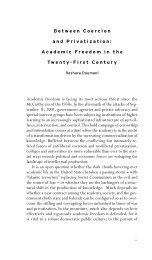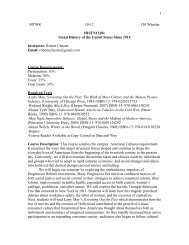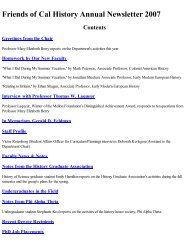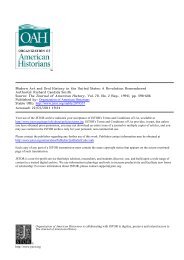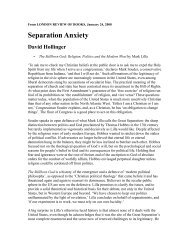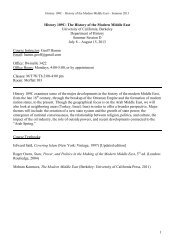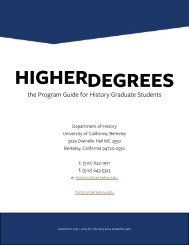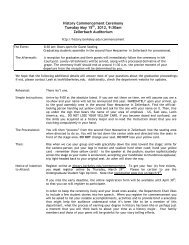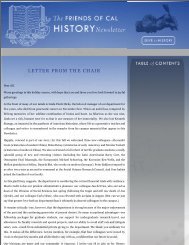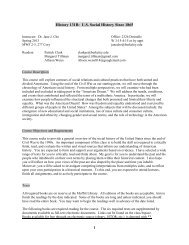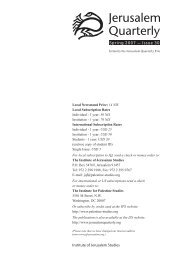David A. Hollinger | Amalgamation and Hypodescent: The Question ...
David A. Hollinger | Amalgamation and Hypodescent: The Question ...
David A. Hollinger | Amalgamation and Hypodescent: The Question ...
You also want an ePaper? Increase the reach of your titles
YUMPU automatically turns print PDFs into web optimized ePapers that Google loves.
this irony is another feature of the history of the United States that comes into clearer focus when thathistory is seen through the lens of the question of ethnoracial mixture. 66<strong>The</strong>re is yet more to see through the lens of our question if we hold our gaze a bit longer <strong>and</strong> broaden 48its scope. By looking back from recent census data on the whole sweep of American history, preparednow to discern mixture even where it was denied by historical actors, we can see unfolding a hum<strong>and</strong>rama for which the vocabulary of the melting pot is not adequate, nor that of miscegenation, nor thatof blood quantum. <strong>The</strong> concept of "assimilation," too, is insufficient, not only on account of itsimplication of a one-way process of newcomers adapting to an unchanging, prior society but alsobecause the concept as commonly understood does not incorporate the prodigious black-white mixingmasked by hypodescent racialization. 67 Nor do the recently popular, ahistorical figures of speech,"mosaic" or "salad bowl," begin to capture the decidedly temporal, dialectical drama that should berecognized as a major theme in the history of the United States, <strong>and</strong> that should again be called by itsproper name: amalgamation.That drama of amalgamation is behind the 1990 census reports I have already mentioned, indicating 49out-marriage rates for young Latinos born in the United States at about 33 percent <strong>and</strong> for AsianAmericans at about 50 percent. 68 On the same charts, the out-marriage rate for American Indians isabout 60 percent. <strong>The</strong> experience of the European descent communities who entered the United Statesin large numbers during the great 1880–1924 migration is also highly pertinent. By the 1990s, personswho identified themselves as having Italian ancestry were acquiring spouses without any such ancestryat a rate of 73 percent, according to demographer Reynolds Farley, <strong>and</strong> the comparable figure for thosewith Polish ancestry was 81 percent. 69 Further from descent-group boundary maintenance are thedescendants of the even earlier generations of migrants from Irel<strong>and</strong>, Germany, <strong>and</strong> Sc<strong>and</strong>inavia.Further still are the descendants of immigrants from Engl<strong>and</strong>, Scotl<strong>and</strong>, <strong>and</strong> Wales, the subdivisions ofGreat Britain that once seemed important to Anglo-Americans. <strong>The</strong>se varieties of white assimilation areoften taken for granted as we contemplate the very different experience of non-European descentcommunities, but in world-historical perspective this mixing of Europeans, too, is far from trivial.<strong>The</strong> case of Jewish Americans invites special attention in view of the fact that Jews, more than 50Italians <strong>and</strong> Poles, <strong>and</strong> the other groups who comprised the migration from Eastern <strong>and</strong> SouthernEurope, were subject to extensive, legally sanctioned discrimination in housing, publicaccommodations, education, <strong>and</strong> employment as recently as World War II. In 1940, Jewish Americanswere marrying non-Jews at a rate of about 3 percent but, by 1990, were doing so at a rate of well over50 percent. 70 Since Jewish Americans have very strong class position, their experience can remind us,once again, that class position often advances or retards rates of intermarriage.<strong>The</strong> Census Bureau tells us that only about 6 percent of African Americans—defined by the 51hypodescent st<strong>and</strong>ard—were acquiring non-black spouses by 1990. 71 <strong>The</strong> final report on this aspect ofthe 2000 census is yet to be released, but preliminary assessments place the figure at about 10 percent. 72Why is the black out-marriage rate so much lower today than the rate for other ethnoracial minorities?Although weak class position on the part of most blacks <strong>and</strong> an enduring prejudice against blacks on thepart of most whites are no doubt prominent factors, <strong>and</strong> would fit with most of the sociological theoryon the dynamics of mixture, there is surely more to it than that. Some blacks have their own reasons forseeking black spouses. This can be true for any community of descent, as internal community adhesivesare often compelling. But there are obvious historical reasons why some American blacks, as opposed tomembers of groups based on immigration, might want as little as possible to do with American whites,today <strong>and</strong> perhaps for a very long time into the future. 73



